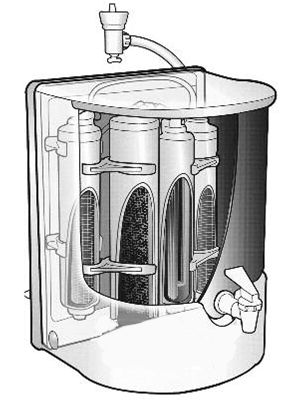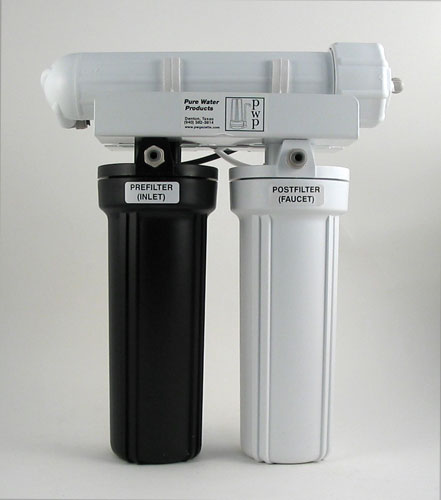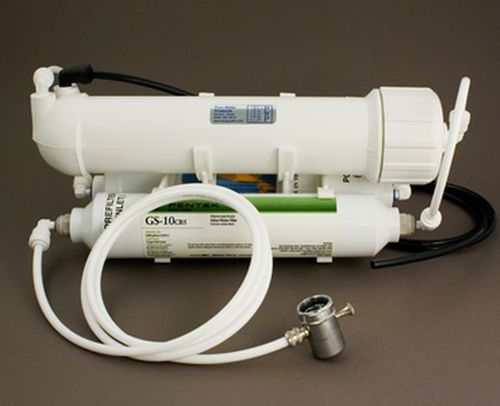How Countertop Reverse Osmosis Units Work
To Read This Issue on Our Website
The Pure Water Occasional's Guide to Countertop Reverse Osmosis Units
|
The compact countertop reverse osmosis unit is one of the most efficient, practical, and cost-effective of all water treatment devices. It is a simple water making machine, with no frills or unnecessary parts. Both initial cost and upkeep expense are low.How it works: The metal diverter valve in the foreground screws onto the sink faucet. It delivers water to the pre-filter (green-labeled vessel), which removes chlorine and chemicals and sends the water on to the membrane (large vessel on top). The black line from the membrane carries the brine (reject water) to the sink, and the white tube beside it sends the permeate (treated water) to the post-filter in back. It exits the post filter through a white tube (not visible in picture) from which it is collected in the user's container. |
Countertop Reverse Osmosis Units
The simple countertop reverse osmosis unit is a much under-valued item. Dollar for dollar (or penny for penny, because countertop RO units don't cost a lot), countertop RO is the most efficient and economical way to produce top quality water.
By way of definition, what sets countertop RO apart from an undersink RO unit, more than the fact that it often sits on the countertop, is the absence of a pressurized storage tank and the incidental small parts that the pressure tank requires. Countertop units produce water, slowly, to be collected in a pressure-free container.
Two styles of countertops are commonly sold. One is a complete-in-itself system that has its own non-pressurized storage bottle built into the unit. This style can itself range from relatively simple to very complicated. Some units require electricity and have built-in pumps and electronic shutoff devices; others run on water pressure only and use a simple float valve as a shutoff. Both simple and complicated usually have the working parts enclosed in a plastic case which can cause space-related design problems and make servicing the unit a challenge.
Below is an inside/outside view of a popular countertop. This is a relatively simple (electricity-free) unit that uses proprietary cartridges and membrane. The diverter valve, shown at the top in both pictures, attaches to the sink faucet. Water enters through the diverter valve and the brine (waste water) exits through the bottom of the same diverter valve into the sink.
 |
 |
| The unit dispenses drinking water via the spout on front of the 1.25 gallon storage tank. Dimension are 14" high and 17" wide. | This is a four-stage unit that uses proprietary cartridges and membrane. The filtration components are clipped together, making servicing the unit fairly easy. |
A Simpler Style
The second style of countertop reverse osmosis is a simpler design that does not provide a storage system of any type. These units simply produce water through an outlet hose to be collected in a container of the user's choosing. These are bare-bones systems that have no extraneous parts. The entire apparatus is devoted to producing water, and appearance is usually not a big consideration.
The unit pictured at the top of this page is one of Pure Water Products' standard countertop RO configurations. It's a simple, three-stage RO unit that uses standard inline carbon filters and a conventional standard-sized membrane. All parts are readily available and easily replaceable. It produces water at the rate of about 2 gallons per hour.
Below is our most popular countertop RO unit. You'll note that it doesn't look like a countertop RO unit.
 |
|---|
Pure Water Products Style A Countertop Reverse Osmosis Unit This classy countertop is a simplified version of our "Black and White" undersink unit. It is pictured here without the diverter inlet and drain and product tubes. It uses the same basic setup as our undersink unit, except the membrane, which is a Filmtec 50 GPD for faster production. This countertop RO has the same lifetime guarantee as our Model 77 countertop filter. It isn't designed to look pretty on the countertop, but its performance is unchallenged. |
Applications for Countertop RO Units
The tank-attached units are limited to one application: sitting on the countertop beside the sink and making drinking water.
For tankless units, however, the uses are limited only by your imagination. Here are some of the more frequent applications:
The most common use is as a bottled water maker. The unit is installed to the sink faucet and allowed to produce water into a bottle. When the bottle is filled, you turn the unit off. You can leave it in place or remove it. It can also be installed in a laundry room or patio--anywhere there's a water source and a drain.
As an aquarium filler. Water is collected in a large container for subsequent addition to the aquarium. An auto shutoff system can be supplied on request that turns the unit off when the container is full.
As an outdoor pond filler. The unit can be allowed to fill
the pond when it is turned on manually or it can be installed to top
off the pond and shut off automatically when the pond is full.
We can supply the unit with a garden hose connection that will allow the user to produce RO water from a garden hose.
To provide final rinse water for a spot-free car wash.
The water must be captured in a small tank, then pumped to provide
pressure for the car wash. A deionizing cartridge can be added to provide zero-TDS water if desired.
To provide high quality water for plants, either in small outdoor gardens or greenhouses. This application also requires capturing then pumping the water to the point of use, although small drip systems could be designed that take water directly from the RO unit.
Pure Water Products Countertops
We've been making countertop units for several years and have come to love their simplicity. Innovations, consequently, have come in the form of making them simpler rather than more complex. If you're willing to discount aesthetics and to sacrifice a bit of convenience, a countertop RO unit is definitely the way to go.
 |
|---|
Both of our countertop units use the reliable QMP diverter that we use on our countertop filters. Note that the tube attaches with a compression nut, not a clamp. This makes it easy to replace should it fail. We can also supply alternative inlet devices, such as garden hose connectors, upon request. |
Both of our basic countertop units follow the same three-stage design.
Style A, pictured above, uses standard-sized 9.75" X 2.5" filter cartridges, so there's an almost unlimited variety of filter substitution possibilities as well as design change possibilities. (We'll build the unit as a four or five stage if you ask, but the standard three stage unit in the picture is our favorite format.)
Standard components are
Prefilter: MatriKX CTO Carbon Block (black housing in the picture).
Membrane: Filmtec 50 Gallon-Per-Day TFC. Produces water at the rate of about 2 gallons per hour, under normal conditions. Production varies according the temperature, quality, and pressure of the inlet water.
Postfilter: MatriKX CTO Plus (formerly called KX-1) Carbon Block (white housing in the picture).
As with our Black and White undersink units, the customer can make cartridge substitutions without adding to the price. Popular alternate cartridges include Doulton ceramic cartridges (bacteria), calcite/carbon post filter (to raise pH and "remineralize"), MatriKX VOC coconut shell carbon block postfilter, deinonizing postfilter cartridge (for absolute zero-TDS), and KDF/GAC prefilter for extra-long dechlorination capacity.
Style A is bracket mounted so that it can be hung on a wall, but it also has flat-bottomed housings, so it can stand alone.
The Style B countertop unit, top picture on the page, is more limited in scope. It uses the same membrane (Filmtec 50 GPD thinfilm), but its cartridges are 10"inline disposables. The current setup is a Pentek carbon block inline as prefilter. The postfilter is an Omnipure coconut shell carbon granular carbon disposable. Both have plenty of capacity for a year's normal residential service between replacements. There are fewer cartridge options for the Style B unit, but any of the 10" inline cartridges on our main website cartridge menu will fit the unit.
Both units are quite easy to service, since all the working parts are easily accessible.
Compared with Undersink RO Units
Countertop RO units, compared with undersink RO systems, have the main disadvantage of inconvenience. The user must provide a collection container and monitor the shutoff, where the undersink unit has its own pressurized storage container which delivers water to a faucet or remote appliance under pressure and turns itself off when its container is full. Countertops, however, have some distinct advantages:
Countertops have the great advantage of not having to produce against the back pressure from the storage tank. This increases their efficiency in TDS reduction and gives them a definite advantage over undersink units in product-to-waste ratio. Stated otherwise, all things being equal, the same membrane in a countertop unit should process a gallon of water while running less water to drain than it would in an undersink unit, and the dissolved solids rejection performance should be a bit better in the countertop. (A permeate pump installed on an undersink unit is an effort to duplicate the back-pressure-free situation enjoyed by a countertop unit. Countertops do not need a permeate pump.)
Other obvious countertop advantages include ease of installation and portability. And don't forget cost. Because countertops have fewer parts than undersink units, they naturally cost less.
You can see our two countertop RO units on our main website.
Pure Water Products
940 382 3814
